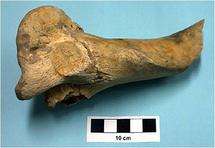Researchers uncover DNA genome sequence of extinct ancient cattle

(PhysOrg.com) -- Researchers, based in Ireland and Britain, have found the complete mitochondrial DNA genome sequence of ancient wild cattle using a sample from a 6,700 year-old bone.
They assembled the mitochondrial DNA sequence from the well-preserved foreleg bone of an aurochs, originally discovered in a cave in Derbyshire. The team’s findings are published in this latest issue of the journal PLoS ONE.
The researchers, from University College Dublin, Trinity College, Dublin, Oxford University and Sheffield and Leeds Universities, extracted the DNA using recently developed DNA sequencing technology. This new DNA sequencing method can extract vast amounts of genetic information very rapidly and was performed at the UCD Conway Institute of Biomolecular and Biomedical Research at University College Dublin.
The mitochondrial DNA genome sequence traces maternal inheritance but the researchers hope the next stage will be to assemble the full nuclear DNA genome of the aurochs. The researchers’ success in determining the first mitochondrial genome sequence raises hopes of reopening the Ancient Biomolecules Centre at the University of Oxford. The centre was mothballed in 2005 but, to further develop this research project at Oxford, the team needs specially filtered laboratories to prevent ancient samples being contaminated by modern DNA.
Co-author Dr Ceiridwen Edwards, a researcher in Ancient DNA Studies at Oxford University, said: ‘This finding heralds what we hope will be the start of a very exciting project to explore the evolutionary history of aurochs and modern cattle. We used newly developed DNA technologies that allow us to extract genetic information much more quickly than we have previously been able to do. This area of research could have implications not only for archaeologists but also for farmers engaged in modern day cattle rearing. In time, we hope to work on sequencing the DNA genomes of thousands of ancient cattle breeds.’
Co-author Professor David MacHugh from University College Dublin said: ‘Our results demonstrate the incredible promise that next-generation DNA sequencing holds for archaeogenetics.’
Previous studies have suggested that ancient aurochs, which lived in the Near East (modern day Iran, Iraq and Syria) and across Europe and Asia, are the ancestor of modern cattle. However, comparisons of European aurochs mitochondrial DNA with modern European cattle suggests that the level of cross-breeding between domestic cattle and the wild, fierce European aurochs must have been very low.
Professor Mark Pollard, Director of Oxford University’s Research Laboratory for Archaeology and the History of Art, said: ‘We need more research into ancient DNA if we are to complete the jigsaw of evolutionary development, not only of cattle but also other species. In the long term, we hope that an Oxford led team could conduct an ambitious DNA project into the migration of plants, livestock and humans across Britain, from the end of the Ice Age to the modern day.’
Provided by Oxford University
















